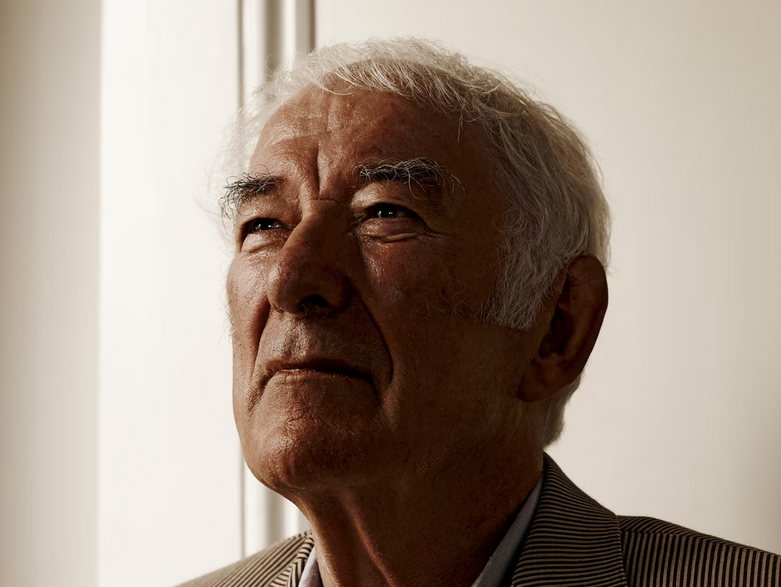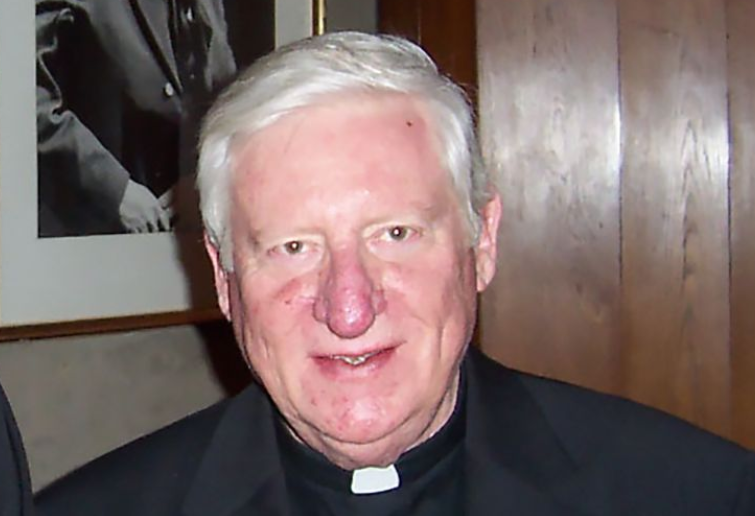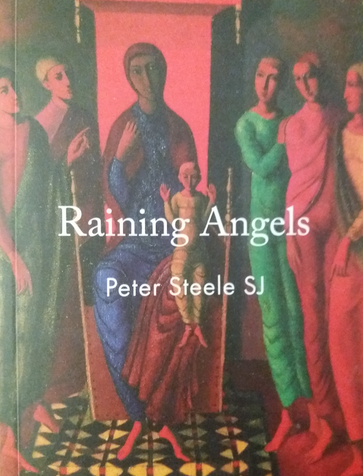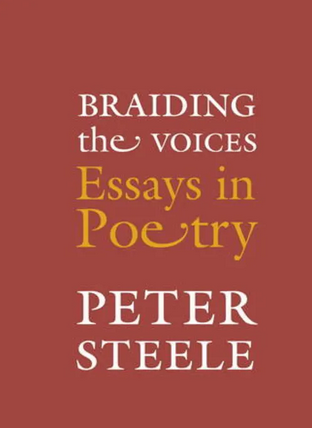
Recalling an acclaimed seventeenth-century priest-poet, the Irish Nobel laureate in literature Seamus Heaney (above) summed up the achievement of Peter Steele, a priest-poet friend, when he wrote to him in 2007: “George Herbert would be proud of you.” Steele had a personal chair in English literature at the University of Melbourne, and spent his academic life at Newman College, one of the four original colleges on the campus.
The last letter Steele received, two days before he died from liver cancer on June 27, 2012, came from Heaney. It ended: “With heavy heart but with love and rich memories it’s a case of Ave, pater, atque vale. Seamus.”
A fellow Jesuit, Steele (below) was a lifelong friend of mine. I met Heaney only once, when he spoke at the Irish College in Rome for the fiftieth anniversary of the death of William Butler Yeats. Heaney, who was to follow Yeats by winning the Nobel Prize, recognised abundantly the poetic genius of Yeats. But being in Rome he did allow himself to say: “Yeats thought of himself as God’s vicar of poetry on earth.” Some relatives of mine would have concurred. They lived in Gort, a town in County Galway, and noticed that self-identification espoused by Yeats when he visited Lady Gregory or stayed in the fourteenth-century Norman tower house Thoor Ballylee. Heaney would later call it the most important building in Ireland.

I wrote Steele’s obituary for the Sydney Morning Herald (July 3, 2012), and reprinted it in Portraits: Popes, Family, and Friends (Connor Court, 2019). The obituary ended with a brief reference to his friendship with Heaney. At the time I had no idea of its rich significance for those two warm, witty and learned poets.
Born in Western Australia in Perth in 1939 a few months after Heaney, Steele became a Jesuit, spent his life at Newman College, and taught generations of students in the University of Melbourne’s department of English literature. In 1993 he was appointed to a personal chair. He held visiting chairs at Georgetown University (Washington DC), the University of Alberta, Loyola University Chicago and Fordham University New York. He also delivered the Martin D’Arcy Lectures (on the passion for autobiography) at the University of Oxford. He published major works on the Irish satirist and Anglican cleric Jonathan Swift.
This essay appears in the latest Quadrant.
Click here to subscribe
Nine years after the death of Steele, at a reception in Newman College, the outgoing provost, Sean Burke, pressed into my hands a collection from Steele, Raining Angels. These poems, mainly sonnets, put into verse episodes from the life of Christ—from the nativity to his death and resurrection. Well over a year later I read what Heaney wrote to Steele: “those New Testament sonnets are wonderful” (letter of January 18, 2011). Through 2022 and 2023, I composed commentaries on Steele’s poems that illuminated Gospel stories. A prize-winning poet and  research student at the University of Melbourne, Manfred Cain, has joined me in this work.
research student at the University of Melbourne, Manfred Cain, has joined me in this work.
For further possible help, I checked the archives of Steele’s home, Newman College. They contained eight letters from Heaney to Steele but no letters from Steele to Heaney. I contacted the archives of the Australian Jesuit province (also in Melbourne), and found to my delight over thirty letters from Heaney to Steele and nearly twenty-five letters from Steele to Heaney.
Paging through publishers’ catalogues a few months ago, I discovered that Faber & Faber planned to put out in October 2023 well over 700 pages of Heaney’s selected correspondence, The Letters of Seamus Heaney (edited by Christopher Reid). By mid-2023, however, this monumental book was already in proof, and it was too late for me to offer the editor the cache of Heaney’s letters in Melbourne.
One of those letters from Heaney (to Emeritus Professor Margaret Manion, October 13, 2012) describes his close friendship with Steele:
It was always a joy and a fortification of sorts to have Peter in the house. As you know he made a point of calling in Dublin when he was on his way to Georgetown [University], and having him in your company was like putting your back to some great tree when the sap was rising.
This letter, written on Steele’s death, sketched Heaney’s feelings about Steele:
I first met him in Loyola University in Chicago and took to him immediately. In fact, from that moment he was like a spiritual director to me—not that he catechized, he simply was his steady, learned, merry, moral self, and his homilies (which would arrive with the poems) were nonpareil: a braiding of faith and intellect.
From the early 1980s, Heaney and Steele continued a correspondence. They sent each other  poems, texts of lectures, and signed copies of their books. Steele also shared with Heaney the homilies he preached Sunday by Sunday. Heaney admitted (letter of September 19, 2007):
poems, texts of lectures, and signed copies of their books. Steele also shared with Heaney the homilies he preached Sunday by Sunday. Heaney admitted (letter of September 19, 2007):
it would be good to be able to boast that I’m a better person for having read the homilies over the years, but I can at least truly report that I’ve been bettered by them as I read, and indeed bested. And this time my special reward was your quote from Augustine, where he avers that to say “I love you” means “I wish you to be.”
Heaney reserved his highest praise for the meditations Steele had been commissioned to write for the Stations of the Cross for the World Youth Day held in Sydney in August 2008. They manage, he said:
as you know better than anyone, to do something extraordinarily difficult and do it without seeming effortful—to match scripture not just with meditation and prayer, but with a style, a level of utterance, a pitch and proffer that will be neither a let down nor a strain up.
Heaney was lavish when commenting on Steele’s poetry. In a letter of June 4, 2011, he found “such a beautiful sense of a convergence of that twain, poetry and theology, of the mind’s gambolling for Christ’s sake, of language-relish from beginning to end”.
Heaney’s letters breathe the trust and esteem in which he held his Australian priest-poet friend. Shared joy, wit, reflections on their poetic craft, and jokes pervade the letters. Heaney and Steele knew their poetic vocation involved them in diving deeper into the human condition. But they never let humour slip out of the picture.
A letter from Heaney (April 6, 1997) mentions what “the chaplain at the Blackrock Clinic [Dublin] said as he walked through the cardiac ward (heard by Barrie Cooke [an Irish painter], as he awaited his bypass): ‘Blessed are the pace-makers’”. In a letter of February 28, 2007, when Heaney knows that Steele has been diagnosed with liver cancer, he wrote:
I think I told you that when I was on my back in the theatre getting ready for the little simple cut that would admit the pacemaker, the surgeon came in togged out in his M.A.S.H. duds and says breezily, “Any questions?” I say, “Do you come here often?” And he, “Only when I’ve a couple of drinks on me.” And I knew I was in good hands. As I know you are too. Let them hold you carefully. With love from her loving self as well [his wife Marie], Seamus.
The compact correspondence between Heaney and Steele could form the script for a remarkable play or even film. Their letters revealed a joyful and generous dedication to the poetic vocation enfolded in the tragic human condition. Parents died; Heaney suffered a stroke in 2006; Steele died in 2012; and Heaney himself died a year later.
Gerald O’Collins, SJ, is professor emeritus of the Gregorian University Rome. His latest books include Letters to Maev (Connor Court), Illuminating the New Testament (Paulist Press), The Spiritual Exercises of St Ignatius of Loyola (Paulist Press) and The Beauty of Jesus (Oxford University Press).
 Sign In
Sign In 0 Items (
0 Items ( Search
Search










Much enjoyed GO’C.
Introduced to Gerard Manley Hopkins SJ at Christian Brothers College Gympie by a fabulous English teacher Bro M L Murphy the alure of acme writing has remained mostly latent since. A focus on science and its formalities served as a bifurcated pathway well distant from the likes of your central characters.
Nevertheless, I find now the time to make some minor inroads into what I have missed and given the need for assistance your piece is just such a vehicle of exploration.
Thank you.
Is there a thesis for the wordsmithing creativity of SJs?